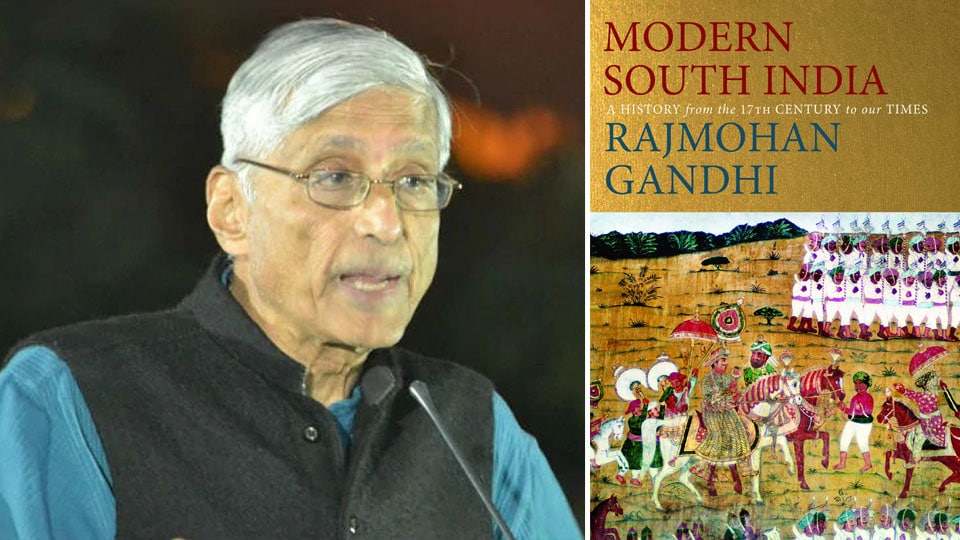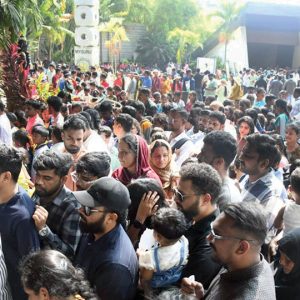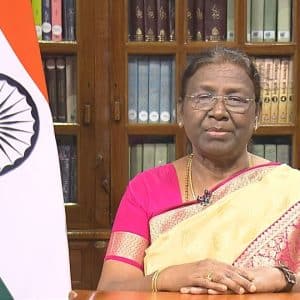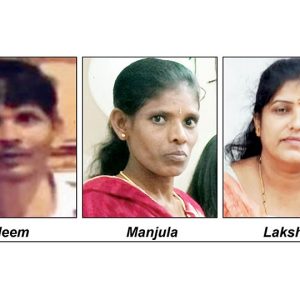This book is the work of Rajmohan Gandhi, a Historian, Biographer
Title: Modern South India: A History from the 17th Century to Our Times
Author: Rajmohan Gandhi
Pages: 507+xx
Price: Rs. 799
Publisher: Aleph Book Company
By Dr. C. D. Sreenivasa Murthy
In recent years, there have not been any books on the History of India, South of Vindhyas. In this well-researched book, the author brings the story of South India and of Southern Culture in Kannada, Malayalam, Telugu and Tamil speaking areas from the period of 16th century to our modern times. The narrative begins at the end of 16th century, when the mighty Vijayanagar Kingdom was eclipsed by the armies of the Bahmani Kingdoms in 1565.
After the fall of this glorious and powerful empire, less powerful sultans, smaller kings and palegars ruled over this region. This was the chaotic period in South Indian history, when the European trading companies started their businesses. There was intense competition between many European Trading companies, particularly between the Dutch, the French and the English. The Portuguese had arrived a century earlier and were well-established. By the 17th century, only the Britishers and French remained to compete and fight it out in the innumerable conflicts of various Indian rulers and Princely States.
The author has brought out very nicely, how the British and the French started trading in South India. There were many big South Indian traders and merchants, who did successful business with the East India Company and the French trading companies. Some of these merchants have left good accounts of their trading activities with East India Company. Many of these men were intelligent and shrewd businessmen. They were generally fluent in many South Indian languages and English. Some of them spoke French too. These polyglots were called Dubashe and helped the foreigners conduct their business activities. In the process these South Indian traders themselves became extremely wealthy and could conduct business with confidence and on equal terms with Europeans. The author mentions about a number of such businessmen.
Ananda Ranga Pillai (1709-61), a Madras-born merchant, who conducted his business from Pondicherry, is one such person. Ranga Pillai was fluent in Tamil, Telugu, Hindustani, French and English. It is interesting to note that he maintained diaries of his daily activities, written in Tamil, in bound volumes of the size of large account books. These diaries have been translated to French and English and throw much light on the commercial and social mores of those times.
The book chronicles how the English who came to trade in Indian spices, cloth and other goods, built small armies to safeguard their small trading posts and forts. For the same purpose they sided with various Princes and played one ruler against the other. From being traders, they became the masters and a ruling class imperceptibly and ended up with an empire to rule.
Gandhi devotes a large part of the book to the history of Hyder Ali and Tipu Sultan. He brings out the various conflicting aspects of Tipu personality. Tipu was a very brave and ruthless warrior and a devout Muslim too. The Maratha warriors, the standard bearers of Hinduism, plundered the Sringeri Temple and Mutt, and looted its immense wealth. When the Pontiff Shankaracharya frantically appealed to Tipu for help, the Sultan immediately dispatched the soldiers and other aid.
Poornaiah, a Brahmin of Tamil origin, was the trusted Dewan of Hyder and Tipu. It appears that Tipu was very keen that Dewan Poornaiah should embrace Islam, but Tipu’s mother dissuaded him. Before departing for the final war with the English, Tipu sent gifts to Lord Ranganatha and the temple priests. After the fall of Srirangapatna, Poornaiah suggested Colonel Wellesley (the future Duke of Wellington who went on to defeat Napoleon at Waterloo), the victor of Srirangapatna, to choose Tipu’s eldest son or one of his descendants as the new Sultan of Mysore. But the English thought differently and restored the kingdom to the Wadiyars.
The English army officers had an extensive network of spies, which helped them to become the masters of this vast country. To quote an example, when Hyder Ali died during one his campaigns far away from the capital Srirangapatna, the English learnt of his death far earlier than his son Tipu could know of it.
History is not merely about intrigues, the wars, the vanquished and the victors. It is also about people and their literature, music, arts and the social aspects of the society. The author writes extensively about the social and caste structure in South India. Many of the British Officers and Christian Missionaries who came with them were erudite and showed great interest in the languages, culture, archaeology and the literature of South India. The British Missionary George Uglow Pope translated and produced the book ‘The Sacred Kurral,’ the verses of Tamil poet Thirukkaral. Charles Philip Brown, a company officer in Kadapa, learnt Telugu and collected the Verses of Vemana, the Telugu poet. Brown was proficient in English, French, Latin, Sanskrit and Telugu. He loved Telugu and collected long forgotten Telugu works. The Oxford University created a Chair for him and appointed him as Professor of Telugu language. Similarly the Christian Pastor of Indian origin Channappa Uttangi, was the first person to publish the collected Kannada verses of Sarvagna in a book form. He writes about the great Trinity of Karnatak music, Thyagaraja, Shyama Shastri and Muthuswami Dikshitar, and Balasaraswathi, Rukminidevi and of M. S. Subbulakshmi of more recent times. It is interesting to note that the great composer Thyagaraja used a word derived from English in one of his krithis.
Some not-so-well-known facts about the social and language struggles in Tamil Nadu are worth mentioning. It appears that the Dravidian leader EVR (E.V. Ramaswami Naicker-Periyar) and some of his followers wanted the creation of an independent Dravidanadu comprising the South Indian States, and in this connection met Jinnah in Bombay. He writes extensively about his grandfather. Rajaji is the only person in modern India, after occupying the highest office as the Governor General, went on to become a Minister in Nehru Cabinet and the CM of Madras Presidency. Rajmohan Gandhi describes the many stubborn qualities of his grandfather and does not hesitate to say that Rajaji had a self-destructive trait. When he was the CM of Madras Presidency prior to independence, presented his Chief Secretary, a white ICS Officer a khadi suit. To the consternation and disapprobation of his white colleagues, the Officer wore it to the office next day. The book is written upto modern times. He writes about PVN and NTR in Andhra, Jayalalithaa and Karunanidhi in TN and H.D. Deve Gowda in Karnataka and many similar politicians in other Southern States.
Mark Twain, the famous American author once said, “India is the cradle of the human race, the birthplace of human speech, the mother of history, the grandmother of legend, and the great-grandmother of tradition. Our most valuable and most instructive materials in the history of man are treasured up in India only.” People without the knowledge of their past history, origin and culture are like trees without roots. Rajmohan Gandhi has authored this History of South India in an easily readable style and without any bias. It is a valuable book for those interested in the story of our past.








Recent Comments